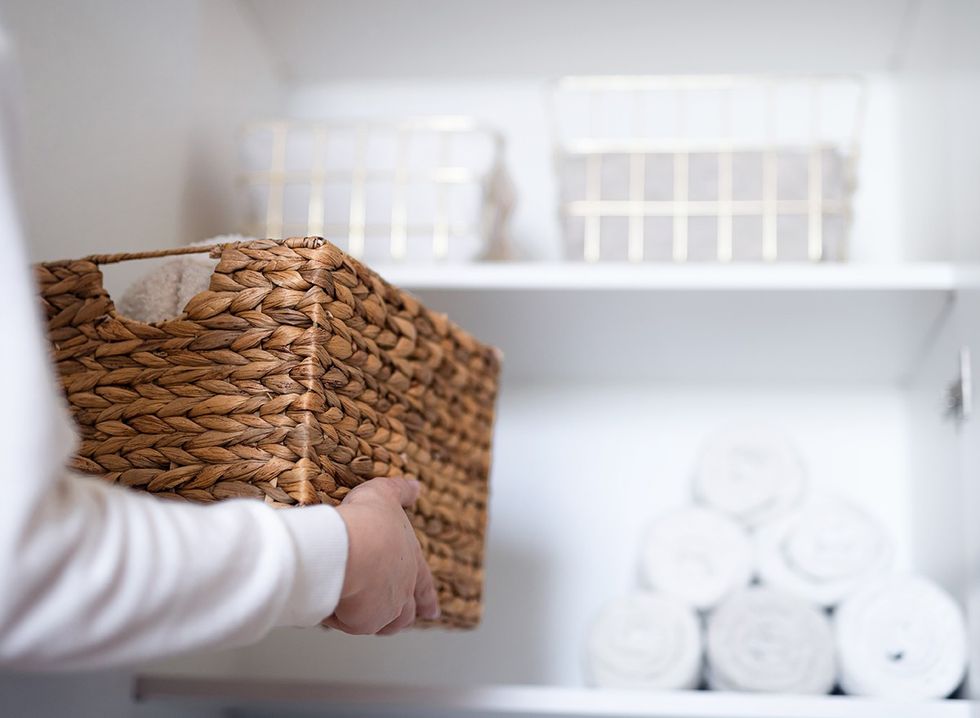Is clutter taking over your home and causing stress? “Several studies show a correlation between disorganization, clutter, and mental health conditions, including, depression, anxiety, and stress,” says Diane Roberts Stoler, EdD, via Psychology Today. “Messy environments can cause frustration, helplessness, and feeling overwhelmed. Decluttering increases self-worth, creates healthy habits, and boosts productivity. A clean and tidy home can also improve sleep, boost mood, and promote relaxation.” Decluttering doesn’t have to be an overwhelming process—here are 7 tricks that will make a big difference, instantly.
RELATED: 10 Simple Steps to Declutter Your Kitchen Fast.
1. Try the Core 4 Method
Shutterstock
The Core 4 Method is: Clear out, categorize, cut, and contain. “This approach involves 1) clearing out the area you want to use — for example, the drawer, cupboard or desk — then 2) categorizing what you have, 3) cutting out the things you don’t want (the most important step!), and then 4) containing what you want to keep,” professional declutterer Susie Boutal tells Country Living. “It’s effective because it clears the space first, which is motivating, provides a sense of achievement early on and allows you to envisage what it will look like. Cutting out what you don’t want is important before you start putting things back. It’s so simple to remember and works for any size project.”
2. Take a Picture
Shutterstock
Take a picture of items that are particularly difficult to part with. “If you have trouble parting with your children’s baby clothes and books or mementos from a vacation, take a picture of them,” Stoler says. “Giving them away often feels like giving up a piece of our identity or our past, making it difficult to let go. By taking a picture of an item that carries sentimental value, you can still have that connection.”
3. The KonMari Method
Shutterstock
The KonMari method is popular for a reason—it’s simple and straightforward. Only keep items that are beautiful or useful. “If you’re struggling to decide what items should stay or go, consider whether they bring you joy or conjure a happy memory. If the answer is no, then it needs to go,” Catharina Björkman tells Country Living.
4. Donate Unwanted Items

Many people are understandably reluctant to throw away useful items. Donating can give those items a new life, and you will be helping others while making your home nicer. “Decide what you’re going to do with your unwanted items: The goal is to get the items out of your house and into the hands of someone who needs them,” Stoler says. “Contact local homeless shelters or donation centers to schedule a drop-off or pick-up.”
RELATED: 10 Steps to Declutter in One Weekend.
5. One Step At a Time

Tackle specific areas in small bursts to prevent feeling overwhelmed.“It’s so easy to bite off more than you can chew when it comes to decluttering,” professional declutterer Liz Mansell tells Country Living. “By breaking down larger goals and starting one cupboard or drawer at a time, you are more likely to succeed and will relish the sense of accomplishment with each completed step. For me, the key areas are the wardrobe, the kitchen drawer, or the bathroom cabinets as these are the home areas used daily, without exception. Seeing the benefit of that small area daily can be enough to spur you on to more decluttering. Once you start, decluttering is infectious!”
6. Stop 10 Minutes Early

However long you give yourself to declutter, always save enough time to put things away. “It allows you to straighten up and relocate items to their homes,” professional organizer Brenda Scott tells Homes & Gardens. “This has been a game changer!’ Brenda shares. “Never leave a mess, it’s worse than not starting at all.”
7. Ask For Help
Shutterstock
Many hands make light work, especially when it comes to decluttering. “Enlist the help of a family member, friend, or paid consultant who can help you make decisions,” Stoler says. “Sometimes getting ‘permission’ from someone else makes it easier to put your items in the donate pile.”




